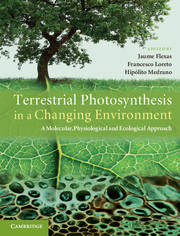 Terrestrial Photosynthesis in a Changing Environment
Terrestrial Photosynthesis in a Changing Environment Published online by Cambridge University Press: 05 March 2013
Introduction
The interest of researchers for a more precise estimation of primary productivity of terrestrial ecosystems and its underlying mechanisms dates back to the 1960s, when the International Biological Programme was launched (Lieth and Whittaker, 1975). At that time, primary productivity was assessed almost exclusively by destructive sampling of plant biomass and measurements of growth, whereas gas-exchange measurements were focused on investigating physiological responses and on model parameterisation. Indeed, estimates of photosynthesis and/or respiration of entire plants or ecosystem was limited by technical problems, and measurements performed on single leaves or plant parts were scaled up using knowledge on plant architecture and ecosystem-structure parameters, such as leaf area index or wood area index (Schulze and Koch, 1971; Tenhunen et al., 1990; Pearcy and Sims, 1994; Matteucci et al., 1995). Nevertheless, knowledge on primary productivity of the terrestrial biosphere increased significantly, and the first attempts of regression modelling were performed (Lieth, 1975; Reichle, 1981).
Since then, the interest for scaling physiological processes in time and space has increased strongly (Ehleringer and Field, 1993; Jarvis, 1995) and a series of new technologies have expanded the spatial scale of observations from leaves to canopy, from ecosystems to globe (e.g., Waring and Running, 1998), and the availability of new measurements, such as canopy fluxes through eddy covariance (EC), remote sensing of absorbed radiation and atmospheric CO2 concentration measurements by tall towers, aircraft or high elevation stations, have improved the understanding of biosphere processes at larger and longer scales, providing better constraints to the estimation of photosynthetic fluxes and carbon-budget components by biogeochemical models (Running et al., 1999; Griffith and Jarvis, 2005).
To save this book to your Kindle, first ensure [email protected] is added to your Approved Personal Document E-mail List under your Personal Document Settings on the Manage Your Content and Devices page of your Amazon account. Then enter the ‘name’ part of your Kindle email address below. Find out more about saving to your Kindle.
Note you can select to save to either the @free.kindle.com or @kindle.com variations. ‘@free.kindle.com’ emails are free but can only be saved to your device when it is connected to wi-fi. ‘@kindle.com’ emails can be delivered even when you are not connected to wi-fi, but note that service fees apply.
Find out more about the Kindle Personal Document Service.
To save content items to your account, please confirm that you agree to abide by our usage policies. If this is the first time you use this feature, you will be asked to authorise Cambridge Core to connect with your account. Find out more about saving content to Dropbox.
To save content items to your account, please confirm that you agree to abide by our usage policies. If this is the first time you use this feature, you will be asked to authorise Cambridge Core to connect with your account. Find out more about saving content to Google Drive.